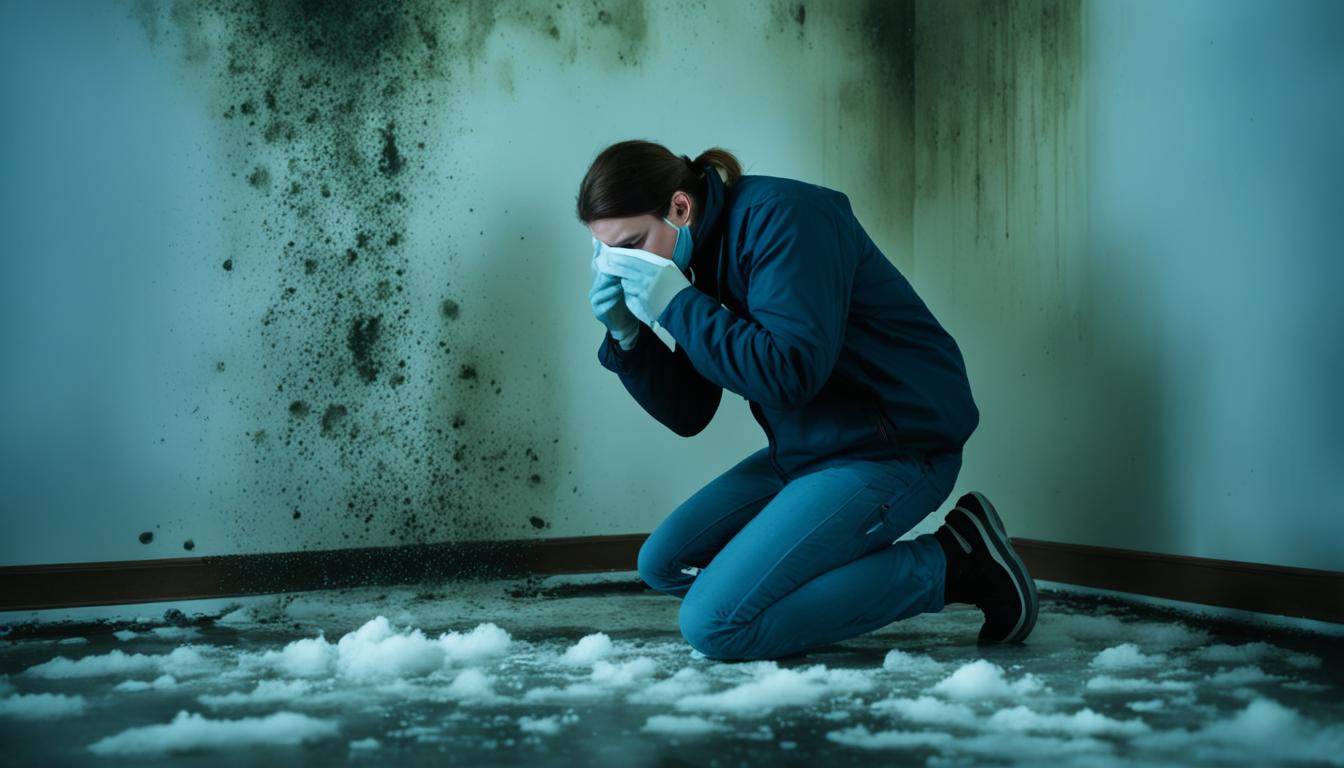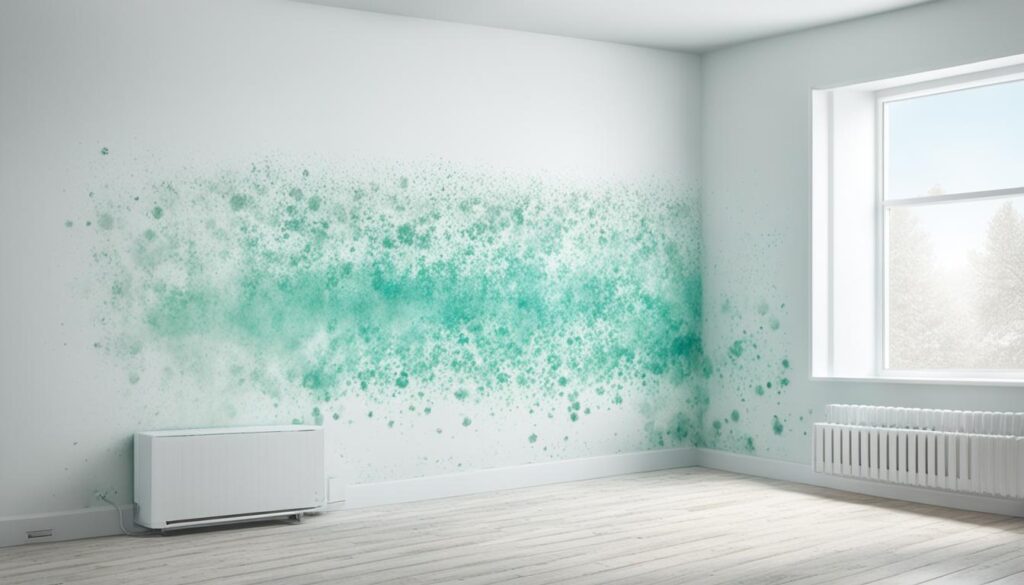
Health Risks of Mold: Why is Mold Dangerous?
Welcome to our comprehensive guide on the health risks of mold and why it is dangerous to our well-being. Mold is a common household issue, often found in damp and poorly ventilated areas, and it can have significant implications for our health. In this section, we will explore the various health risks associated with mold exposure and shed light on the dangers it poses.
Mold exposure can lead to a range of health problems, particularly for individuals with existing respiratory conditions or compromised immune systems. The effects of mold on our health can vary depending on the type of mold and the duration of exposure. It is essential to understand the potential dangers and take necessary precautions to protect our health.
- Mold exposure can have detrimental effects on our respiratory system and overall well-being.
- Prolonged exposure to mold can trigger allergies and lead to respiratory conditions such as asthma.
- Certain molds can produce toxins, posing additional health risks.
- Prevention is key in avoiding mold-related health issues.
- Regular mold assessments and proper moisture control can help prevent mold growth in our homes and workplaces.
Understanding Mold Exposure
Mold exposure can have significant health implications that shouldn’t be ignored. In this section, we will explore the various ways in which we can come into contact with mold and the potential dangers associated with black mold. Additionally, we’ll take a closer look at the common symptoms of mold exposure and the range of illnesses that can arise from extended contact.
Exposure to mold can occur in different ways, depending on our environment. Whether it’s in our homes, workplaces, or public spaces, mold can thrive in damp and humid conditions, lurking in hidden corners or even within the walls.
The Dangers of Black Mold
Black mold, also known as Stachybotrys chartarum, is a particularly concerning type of mold due to its potential health hazards. It is characterized by a greenish-black color and a slimy texture. Black mold releases spores into the air, which can be easily inhaled, leading to health problems.
Mold spore inhalation can trigger various symptoms, ranging from mild to severe, depending on the level of exposure. Individuals with weak immune systems, respiratory problems, or pre-existing health conditions are often more susceptible to the effects of mold exposure.
Symptoms of Mold Exposure
The symptoms of mold exposure can vary from person to person, and the severity can depend on factors such as the type and amount of mold present. Some common symptoms of mold exposure include:
- Coughing and wheezing
- Sneezing and nasal congestion
- Itchy, watery eyes
- Throat irritation
- Headaches
- Fatigue
Long-term exposure to mold can also contribute to the development of more serious health conditions, such as respiratory infections, asthma, allergies, and even mold-related illnesses.
It is important to note that symptoms may not always be immediately apparent, and some individuals may be more sensitive to mold than others. If you suspect mold exposure or experience any of these symptoms, it is advisable to consult with a healthcare professional to determine the best course of action.
“Mold exposure can have detrimental effects on our health, especially black mold. It’s crucial to be aware of the symptoms and seek prompt assistance to mitigate the risks and prevent further health complications.”
Considering the potential dangers associated with mold exposure, it is essential to address any mold issues promptly and take preventive measures to minimize the risk. In the next section, we will explore the specific health effects of mold exposure, focusing on how it can impact our respiratory system and overall well-being.
The Impact of Mold on Health
In this section, we will explore the specific health effects of mold exposure. Mold, especially when present in high concentrations or over extended periods, can have detrimental effects on our respiratory system and overall well-being.
Respiratory System
Mold spores, when inhaled, can irritate the respiratory tract and lead to various respiratory conditions. Individuals with pre-existing respiratory conditions, such as asthma or chronic obstructive pulmonary disease (COPD), are particularly vulnerable to the effects of mold exposure. Common symptoms include coughing, wheezing, chest tightness, and shortness of breath.
Allergies and Sensitivities
Exposure to mold can trigger allergic reactions in susceptible individuals. Common mold-related allergies include sneezing, nasal congestion, itchy or watery eyes, and skin rashes. Some individuals may also develop sensitivities to specific molds, experiencing more severe symptoms upon exposure.
“Mold-induced allergies can be particularly problematic for those with compromised immune systems,” says Dr. Emily Thompson, an allergist at Allergen Solutions. “Repeated exposure can worsen symptoms and lead to chronic allergic rhinitis or asthma.”
Toxic Mold Effects
Certain types of molds, such as Stachybotrys chartarum (often referred to as “black mold”), produce mycotoxins that can be harmful to human health. These mycotoxins can enter the body through inhalation, ingestion, or skin contact and may have toxic effects on various organs and systems.
Research suggests that toxic mold exposure can contribute to a range of health issues, including neurological symptoms such as headaches, difficulty concentrating, and memory problems. It may also affect the immune system and lead to fatigue, general malaise, and joint pain.
While the severity of health effects may vary depending on individual susceptibility, prolonged exposure to toxic molds should be taken seriously and addressed promptly.
Mold Impact on Overall Well-being
In addition to the specific health effects mentioned above, the presence of mold in our indoor environments can negatively impact our overall well-being. The knowledge of a mold infestation can cause stress, anxiety, and even affect mental health.
Furthermore, mold-related illnesses can result in the disruption of daily activities and quality of life. It is crucial to address mold issues promptly and take preventive measures to create a safe and healthy living environment.

Preventing Mold Growth
When it comes to mold, prevention is key. By taking proactive measures, you can effectively reduce the risk of mold growth in your homes and workplaces. Implementing strategies such as proper ventilation, moisture control, and regular mold assessments can help create a mold-free environment. Let’s explore these preventive measures in detail:
Ventilation
Good ventilation plays a vital role in preventing mold growth. Proper air circulation helps minimize moisture levels, which in turn inhibits mold development. Ensure that your indoor spaces are adequately ventilated, especially in areas prone to high humidity, such as bathrooms, kitchens, and basements.
Moisture Control
Moisture is a major catalyst for mold growth. It’s crucial to address any sources of excess moisture and fix any leaks promptly. Regularly inspect your plumbing systems, roofs, and windows for signs of leakage. Utilize dehumidifiers in areas with high humidity to maintain optimal moisture levels.
“Prevention is better than cure when it comes to mold. By implementing effective moisture control methods and maintaining proper ventilation, we can significantly reduce the risk of mold growth.” – Dr. Jane Smith, Mold Expert
Regular Mold Assessments
Regular mold assessments are essential in preventing mold growth and ensuring a healthy living or working environment. These assessments involve professional inspections to identify any potential mold sources, assess the extent of mold presence, and provide recommendations for remediation if necessary.
| Preventive Measures | Benefits |
|---|---|
| Proper ventilation | Reduces moisture levels and inhibits mold growth |
| Moisture control | Addresses potential sources of excess moisture and prevents mold development |
| Regular mold assessments | Detects mold early, allowing for prompt remediation and prevention of further mold-related issues |
Remember, mold prevention is a proactive approach that requires consistent efforts in maintaining a dry and well-ventilated environment. By implementing these preventive measures and conducting regular mold assessments, you can significantly reduce the risk of mold-related problems and ensure a healthier living or working space.

Early Signs and Detection
Identifying the presence of mold in our environment is crucial for our health and well-being. By being aware of the early signs and knowing how to detect mold infestations, we can take swift action to mitigate the risks and protect ourselves from mold-related illnesses and mold toxicity.
Here are some common indications that may suggest the presence of mold:
- Unpleasant musty odor: If you notice a persistent, earthy smell in your home or workplace, it could be a sign of hidden mold.
- Visible mold growth: The presence of visible mold on walls, ceilings, floors, or other surfaces indicates an active mold problem.
- Allergic reactions: Frequent allergic symptoms such as sneezing, coughing, watery eyes, and nasal congestion when indoors can be a sign of mold presence.
- Respiratory issues: Mold spores can trigger or worsen respiratory conditions such as asthma, bronchitis, or allergic rhinitis.
Early detection is essential in preventing mold-related illnesses and minimizing potential health risks. If you suspect mold in your environment, it’s important to take immediate action to address the issue.
“The presence of mold can lead to a range of health problems, from minor allergies to severe respiratory illnesses. Early detection allows for timely intervention, ensuring a healthier living or working environment.”
However, mold can sometimes be challenging to detect, especially when hidden in hard-to-reach areas or behind walls. In such cases, it is recommended to seek professional help.
A certified mold inspector or remediation specialist has the knowledge, expertise, and tools required to accurately assess the extent of mold contamination and provide effective solutions to eliminate mold and prevent its recurrence.
Remember, prompt detection and proper remediation are key to safeguarding your health and creating a mold-free environment.
Seeking professional help for mold assessment and remediation ensures that the necessary precautions are taken to protect yourself and your loved ones from the health risks associated with mold exposure. Don’t hesitate to reach out to experts who can guide you in identifying, addressing, and preventing mold-related issues.
Conclusion
In conclusion, the health risks of mold exposure are significant and should not be underestimated. Mold poses dangers to our well-being, as it can trigger various respiratory conditions and allergies. It is crucial to be aware of the potential health effects and take proactive measures to prevent mold growth in our living and working spaces.
By implementing effective mold prevention strategies, such as proper ventilation and moisture control, we can create a mold-free environment. Regular mold assessments are also essential to identify any early signs of mold infestation and address them promptly.
Protecting our health from the dangers of mold exposure requires knowledge, vigilance, and action. Being aware of the health risks associated with mold is the first step towards prevention. By taking preventive measures and seeking professional help when needed, we can safeguard our well-being and ensure a healthier living environment for ourselves and our loved ones.




